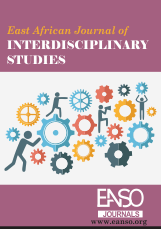Exploring the Latent Roles of Indigenous Chickens among Rural Households in Kericho County, Kenya: A Grounded Theory Approach
Abstract
Chickens are the most popular poultry worldwide. About 23.7 billion chickens globally in 2018 were reared mainly for their eggs and meat products. Indigenous chickens in Kenya constitute about 70% of the poultry population. Their role in rural livelihoods is widely understood in terms of provisioning for nutrition and household income. This study aimed to investigate, through a community-based participatory process, the latent roles of indigenous chicken (IC) in the livelihoods of smallholder farmers in rural areas of Kericho County, Kenya. This study adopted a Grounded Theory Approach and a Community-based Participatory action research design. Six sites in three out of six sub-counties were selected for the study based on their agroecological zones and administrative locations. Data were collected through focus group discussions and interviews. Community-based participatory action research tools; focus groups, resource mapping, role plays, and community workshops, were used to encourage participation and knowledge sharing. Data were collected through note-taking and group presentations. The data were analyzed using the grounded theory constant comparative method. Analysis revealed that the higher order concepts and theories that could explain the latent roles of indigenous chickens were1insurance against shocks, 2marketness; sales for income, 3instrumentalism; as an instrument for personal motivations, 4ecological functions and5immanent roles; to utilize existing resources and capabilities. It has roles as a socio-economic 6ladder-of-change, contributes to 7household functionalism by engaging youth and women and household 8dietary needs, and social roles in 9interpersonal connectedness. In conclusion, indigenous chickens had roles in the economy, ecology, socio-culture and food supplies. This understanding has implications in formulating strategies by development agents, for sustainable IC production. Further research in different contexts to build on the in-depth understanding of the IC roles is recommended.
Downloads
References
Abbasi, I.A., Ashari, H., Ariffin, A. S., & Yusuf, I. (2023). Farm to Fork: Indigenous Chicken Value Chain Modelling Using System Dynamics Approach. Sustainability, 2023, 15, 1402. https://doi.org/10.3390/su15021402
Ament, J., Tobi, D., Merrill, S., Morgan, C., Morse, C., Liu, T., &Trubek, A. (2022). From Polany to Policy: A tool for measuring embeddedness and designing Sustainable Agricultural Policies. Frontiers in Sustainable Food Systems. DOI:10.3389/fsufs.2022.983016
Anirudh, K. (2005). Stages of Progress: A Community-based Methodology for defining and understanding poverty. Duke University (USA).
Biswas, T.D., & Mukherjee, S.K. (Eds.) (2016). Text Book of Soil Science (2nd Ed.). McGraw Hill Education (India) Private Limited, New Delhi.
Braun, V., & Clarke, V. (2013). Successful Qualitative Research: A Practical Guide for Beginners. London: SAGE Publications Ltd.
Chambers, R. (1986). Rural Development: Putting the Last First. Longman Scientific & Technical (UK).
Chambers, R., & Conway, G.R. (1992). Sustainable Rural Livelihoods: Practical Concepts for the 21st Century (IDS Discussion Paper 296). Institute of Development Studies.
Charmaz, K. (2006). Constructing Grounded Theory. SAGE Publications.
County Government of Kericho (2014). Strategic Plan 2014-2017. County Government of Kericho, Republic of Kenya
Food and Agriculture Organization of the United Nations, FAO (2020). Kenya at a glance. Retrieved from http://fao.org/kenya/fao-in-kenya/kenya-at-a-glance/en/.
Franz, N.K., Piercy, F., Donaldson, J., & Richard, R. (2010). How farmers learn: Implications for agricultural educators. Journal of Rural Social Sciences, 2010, 25 (1), 37-59.
Glaser, B. G. (2002). Conceptualization: On Theory and Theorizing Using Grounded Theory. International Journal of Qualitative Methods, 1(2), 23– 38. https://doi.org/10.1177/160940690200100203.
Huffman, T. (2017). Participatory/Action Research/CBPR (Chap.). In: Jorg Matthes (Ed.), The International Encyclopedia of Communication Research Methods. John Wiley & Sons, Inc. Available: https://doi.org/10.1002/9781118901731.iecrm0180
Kennedy, O.B., Barbara, J. Mitchel P.C., &Thurnham, D.I. (2005). Flesh Colour Dominates Consumer Preference for Chicken. Appetite, 44 (2005): 181-186.
Kenya National Bureau of Statistics, KNBS (2019). 2019 Kenya Population and Housing census volume IV: Distribution of population by Socio-economic characteristics. Kenya National Bureau of Statistics, Nairobi, Kenya.
Kolb, S. M. (2012). Grounded theory and the constant comparative method: Valid research strategies for educators. Journal of emerging trends in educational research and policy studies, 3(1), 83-86.
Kumar, R. (2019). Research Methodology: A Step by Step Guide for Beginners (5th Ed). London: New Age.
Lesley, C. (2023, November 16). Chicken Behaviors: Dust Bathing, Mating, Preening, and More. The Old Farmer’s Almanac.https://www.almanac.com/chicken-behaviours-dust-bathing-mating-preening-and-more
Morse, S., & McNamara, N. (2013). Sustainable Livelihood Approach: A critique of Theory and Practice [Online]. DOI: 10.1007/978-94-007-6268-8
Msoffe, P., Msoffe, F., & Mgeni, T.A. (2010). Characterisation of Indigenous Chickens in Tanzania: Challenges and Opportunities for Improvement. International Journal of Poultry Science, 9 (8), 763-772.
Njuguna, K.C., Kabuage, L.W., & Bett, E.K. (2017). Economic analysis of indigenous chicken production: The case of smallholder farmers in Makueni and Kakamega counties, Kenya. International Journal of Agricultural Extension and Rural Development, 5(5), 564-540.
Odeyemi, O.A., & Ojo, O.S. (2015). Impact of Indigenous Poultry on household food security in Nigeria. International Journal of Research in Agriculture and Food Sciences, 1(1), 21-26.
Ormerod, R. (2019). The history and ideas of sociological functionalism: Talcott Parsons, modern sociological theory, and the relevance for OR. Journal of the Operational Research Society, 71(12), 1873– 1899. https://doi.org/10.1080/01605682.2019. 1640590
Padhi, M.K. (2016). Importance of indigenous breeds of chicken for rural economy and their improvements for higher production performance [online]. Scientifica, Vol. 2016. Retrieved from: http://dx.doi.org/10.1155/2016/2604685
Roman, D. J., Osinski, M., & Erdmann, R. H. (2017). A substantive theory on the implementation process of operational performance improvement methods. Revista de Administração, 52 (2), 148–162. https://doi.org/10.1016/j.rausp.2016.12.005
Thornburg, G.K. (2013). Embeddedness, Marketness and Economic Instrumentalism in the Oklahoma Farm-to-school Program. Journal of Rural and Community Development, 8(3): 321-334.
Udo, H., & Bassey, A. (2004). Economic Analysis of Indigenous Chicken Production in Rural Nigeria. African Journal of Agricultural Research, 1 (3): 124-130.
Uzundumlu, A.S., & Dilli, M. (2023). Estimating Chicken meat productions of leader countries for 2019-2025 years. Ciência Rural, 53 (2). Available: https://doi.org/10.1590/0103-8478cr20210477
Van Bel, D.T., IJssselsteijn, W.A., & de Kort, Y.A. (2008). Interpersonal Connectedness: Conceptualization and directions for a measurement instrument. Paper Presented at the CHI 2008 Conference, April 5-10, 2008, Florence, Italy.
Copyright (c) 2025 Joseph K. Cheruiyot, Joash K. Kibett, PhD, Michael E. Omunyin, PhD, George M. Kere, PhD

This work is licensed under a Creative Commons Attribution 4.0 International License.




























